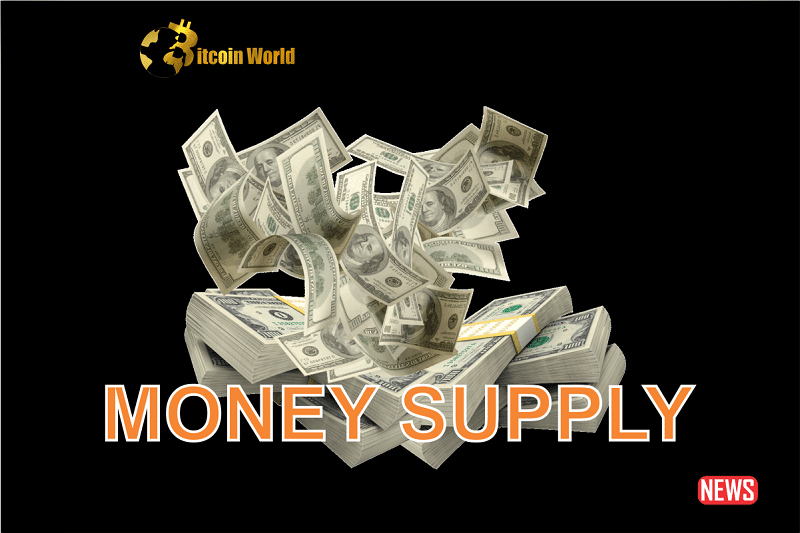Remember the early days of the pandemic? Amidst the lockdowns and uncertainty, governments worldwide rolled out unprecedented stimulus measures. In the US, this response triggered what some are calling a ‘monetary tidal wave.’ Imagine this: a staggering amount of new dollars flooding the economy. In fact, some reports suggest the central bank printed roughly 80% of all US dollars currently circulating since 2020. That’s a financial earthquake with aftershocks we’re still feeling today.
A Shocking Revelation: How Much Did the Money Supply Really Increase?
The sheer scale of this monetary expansion is hard to grasp. On August 27th, The Kobeissi Letter dropped a bombshell, revealing a jaw-dropping 375% increase in the number of dollars in circulation in just three years. Let’s break that down:
- Pre-Pandemic (Early 2020): Approximately $4 trillion in circulation.
- Present Day (According to The Kobeissi Letter): A staggering $19 trillion in M1 circulation.
That’s an extra $15 trillion injected into the system! This massive injection of liquidity was intended to be an economic lifeline, supporting individuals and businesses grappling with the fallout from lockdowns. But has it worked as intended? Many are now questioning the long-term costs of this financial intervention.
The Unintended Consequences: Are We Reaping What We Sowed?
As one commentator aptly put it, “We are now reaping the benefits of overnight trillions of dollars.” While the initial intention was to cushion the economic blow, the reality has been far more complex. One of the most prominent consequences has been the surge in inflation. Think about it: when there’s more money chasing the same amount of goods and services, prices tend to rise. And that’s precisely what we’ve seen.

Inflation’s Grip: Is the ‘Transitory’ Narrative Truly Over?
Remember when inflation was labeled ‘transitory’? That now seems like a distant memory. While there has been some recent easing, inflation remains a persistent concern. Consider this:
- Recent Inflation Spike: In July, US inflation ticked up to 3.2%, interrupting a period of gradual decline.
- The Fed’s Response: Federal Reserve Chairman Jerome Powell has indicated that further interest rate hikes are possible if inflation remains stubbornly high.
This persistent inflation significantly erodes purchasing power. That dollar in your pocket simply doesn’t buy as much as it did just a few years ago. It’s a real-world impact that hits everyday Americans hard.
The Household Squeeze: Are Americans on a Financial Tightrope?
The current economic landscape paints a concerning picture for the average US household. Look at these figures:
| Financial Metric | Average Amount |
|---|---|
| Credit Card Debt | $7,300 |
| Savings Balance | $5,300 |
This stark contrast highlights the precarious financial position many find themselves in. The rising cost of essentials makes it increasingly difficult to make ends meet, and the promise of ‘free money’ feels like a distant illusion.
The Dollar’s Global Standing: Still King, But for How Long?
Despite the domestic challenges, the US dollar still holds significant sway in international transactions. Bloomberg data recently showed it topping 46% of foreign transactions. However, a growing trend of ‘de-dollarization’ is gaining momentum. More and more countries are exploring conducting trade in their own currencies. The recent suggestion by Brazil’s President for a common BRICS currency is a prime example. This shift could have significant long-term implications for the dollar’s global dominance.
Looking Ahead: Navigating the New Economic Reality
The pandemic-induced stimulus measures undeniably unleashed a massive wave of liquidity into the US economy. While intended to provide a safety net during a crisis, the long-term consequences are becoming increasingly clear. From rising inflation to the erosion of purchasing power, the ‘monetary tidal wave’ has left a significant mark. The future remains uncertain, but understanding the forces at play is crucial for navigating this new economic reality.
The experiment of injecting trillions into the economy has undoubtedly rewritten some of the economic playbooks. Whether the long-term effects will ultimately be beneficial or detrimental is a question that will continue to be debated and observed in the years to come.
Disclaimer: The information provided is not trading advice, Bitcoinworld.co.in holds no liability for any investments made based on the information provided on this page. We strongly recommend independent research and/or consultation with a qualified professional before making any investment decisions.


